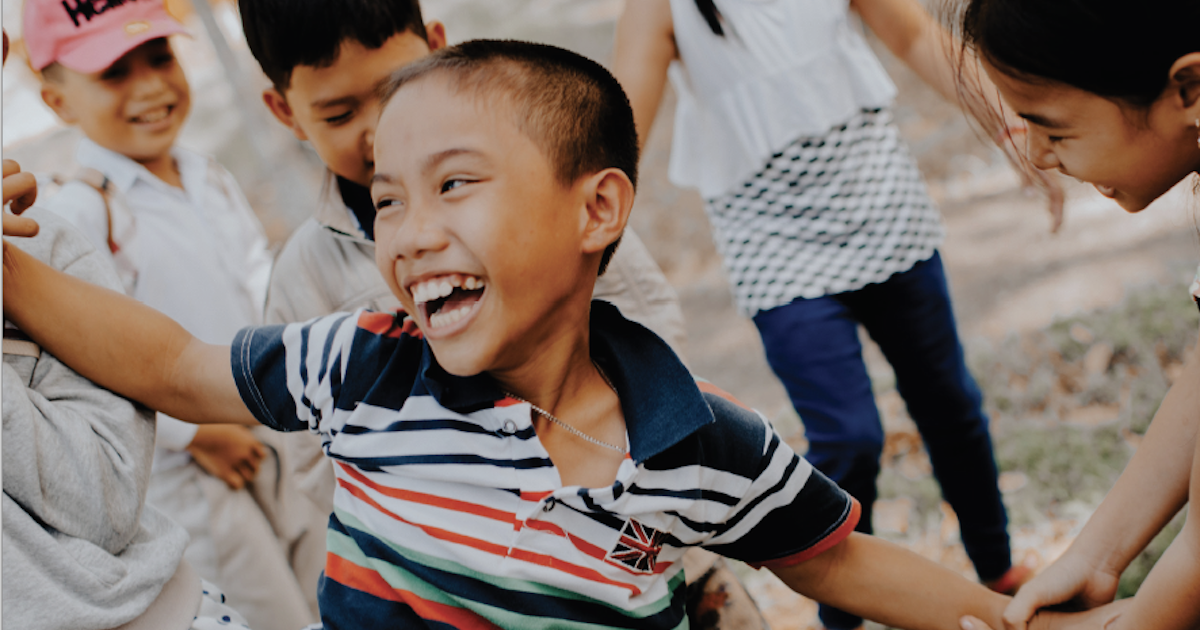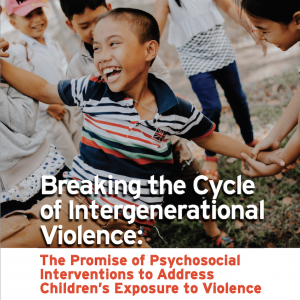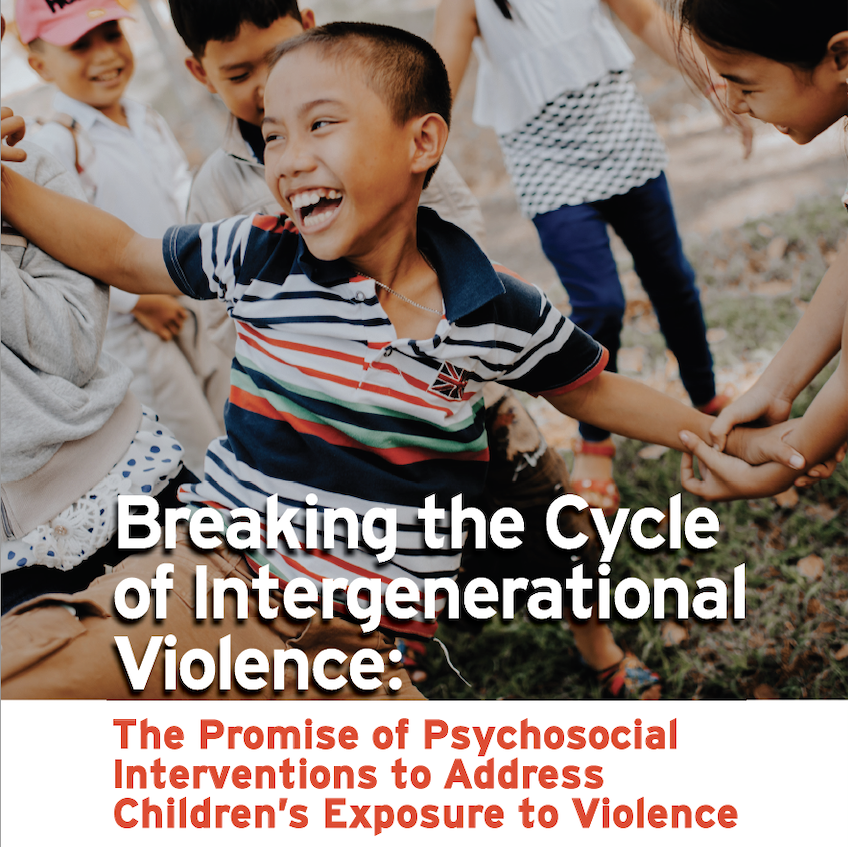 Exposure to violence in childhood can take an enormous toll on children’s mental and physical health now and in the long-term; it can also impact their future productivity and relationships. Importantly, children’s direct experiences with or witnessing of violence are strongly linked with perpetrating or experiencing intimate partner violence (IPV) as adults.
Exposure to violence in childhood can take an enormous toll on children’s mental and physical health now and in the long-term; it can also impact their future productivity and relationships. Importantly, children’s direct experiences with or witnessing of violence are strongly linked with perpetrating or experiencing intimate partner violence (IPV) as adults.
This association – often called the intergenerational cycle, or transmission of violence – is impacted by factors which include: the long-term psychological and physiological consequences of multiple types of direct violence or exposure to violence; unequal gender norms; and the ways in which children are raised or socialized.
Despite studies that reaffirm both the mental health impacts of exposure to violence in childhood, as well as its ability to drive men’s violence against women later in life, there has been little discussion of how we can work with children affected by violence as an important priority strategy to prevent gender- based violence.
When offered as part of a comprehensive suite of violence against women and violence against children prevention and response services, quality, targeted interventions that meet children’s psychological and social support needs have the potential to disrupt cycles of violence.
A new report, Breaking the Cycle of Intergenerational Violence: The Promise of Psychosocial Interventions to Address Children’s Exposure to Violence, commissioned by Equimundo, launched today. It includes reviews of interventions – across many settings in high- and low-income countries, in individual and group/community settings, and facilitated by formally-trained professionals as well as community-trained facilitators – which show promise in supporting children’s health and well-being, and in preventing future perpetration or experiences of violence.
It is imperative to emphasize that psychosocial support for children exposed to violence is only one element of a comprehensive suite of services, programs, and policies to respond to, address, and prevent violence against women as well as violence against children, including psychosocial, health, and safety services for women themselves.
The report finds that:
1. Approaches working directly with individual children have varying levels of effectiveness for participants.
- Cognitive behavioral therapy (CBT) with a trauma focus is the most effective intervention for children aged 3 to 18 who have a history of violence or trauma. A flexible, components-based treatment model made up of individual child and non-offending parent sessions, as well as joint non-offending parent-child sessions, CBT interventions have been shown to improve children’s safety skills and symptoms and to have enhanced parenting skills, according to evidence.
- Interpersonal therapy (IPT), a brief intervention originally developed in the United States for individuals, focuses on helping participants deal with social struggles; IPT guides participants to help them resolve conflict, cope with grief, overcome transition-/life change-related circumstances, and handle difficulties related to social isolation; this approach is effective in treating diagnoses from depression and anxiety to post-traumatic stress disorder (PTSD) and borderline personality disorder; IPT-A (interpersonal therapy for depressed adolescents) shows promise as a culturally-relevant and stigma-reductive intervention with potential to reduce depression.
- Mindfulness and yoga techniques provide encouraging outcomes when it comes to reducing stress, anxiety, and depressive symptoms; they may be particularly effective in helping to address physical dissociation sometimes experienced by survivors of violence and to improve body awareness.
2. School-based interventions provide opportunities to address childhood trauma with children who display symptoms as well as to support mental health more broadly.
- Classroom-based interventions show promise, in particular, for reducing PTSD and increasing and sustaining hope among children.
- Universal school approaches, such as trauma-informed or trauma-sensitive schools have increased wellness in at-risk communities, and improved overall academic and emotional success for students.
- Interventions that take a whole-school approach, i.e., that provide school-wide programming and targeted programs for students with greater needs show high potential: for example, SEHER, a health promotion intervention in Bihar state, India, was shown to be effective in addressing depression, bullying, and violence victimization, among others.
3. Community-level interventions can be effective when delivered as complements to more targeted interventions.
- Child-friendly spaces, safe spaces set up in the aftermath of humanitarian disasters or conflict, show overall positive trends in terms of psychosocial well-being for children; stronger impacts have been observed for younger children as well as in settings where mental well-being is more strongly emphasized.
The report provides a necessary and crucial reminder of the long-term impacts of gender-based violence and gender inequality. Psychosocial support as a violence prevention strategy is at the nexus of the often-siloed fields of violence against women (VAW) and violence against children (VAC). As such, it requires careful attention to the tensions and risks of working across these fields, including to issues of agency, representation, and appropriate legal and protection frameworks.
There is an urgent need for mental health and psychosocial support interventions for children, not only to improve their long-term health and well-being but also to prevent future violence in intimate relationships. Evidence-based psychosocial services for those exposed to violence have enormous potential to break cycles of violence and improve the well-being of children and adults around the globe.
Further investigation and evaluation into the promise of mental health interventions as a way to prevent violence should be conducted. It is necessary to determine how these and other – interventions can bolster primary prevention efforts seeking to challenge and transform the gender norms that lead to violence; there is also an opportunity to investigate how trauma-focused mental health programs for adults could be adapted for children and adolescents.
Future work related to policy change and funding requires governments and donors to invest in building the evidence base and expanding existing mental health and psychosocial services. This holistic approach is necessary for children and adolescents to have futures that are more connected and that are characterized by mental and emotional well-being.
Read the full report here.

